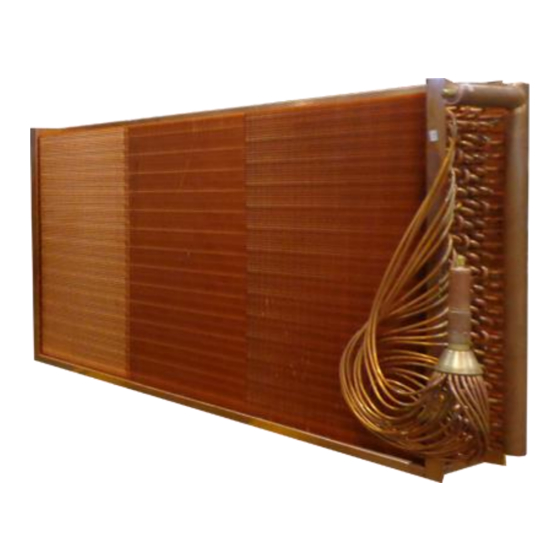DIRECT COIL REFRIGERANT COILS Manual de instalación y funcionamiento - Página 3
Navegue en línea o descargue pdf Manual de instalación y funcionamiento para Sistema de agua DIRECT COIL REFRIGERANT COILS. DIRECT COIL REFRIGERANT COILS 8 páginas.

Introduction
Custom designed for specific use; Direct Coil takes pride
in enabling customization from design to manufacture.
Variations are offered in design, connections, casing, fins,
circuitry and materials.
Extensively tested and sized using proprietary software,
Direct Coil refrigerant coils are designed for comfort
conditioning, heating and industrial applications.
Types
Direct Coil manufactures two varieties of refrigerant
coils: expansion coils which expand liquid refrigerant and
cool the airflow, and condensation coils, which work by
condensing refrigerant and warming the airflow.
Most condenser coils resemble water coils, however
expansion coils come with a single connection and a
distributor valve with copper pipes that feed the coil.
Features
A refrigerant coil has five main features:
-
Connections
-
Casing
-
Fins
-
Headers
-
Distributor(s) (only direct expansion coils)
Nomenclature
Any coil is designated a standard Direct Coil model
number.
Ex., 5DC-02-30.0-08-45.0-20
5 ➔ Tube OD
This parameter is codified by the following table
Figure 1 - Handing and Header Location
Number
Tube OD
2
5/16
1
3/8
3
3/8
6
3/8
4
1/2
7
1/2
5
5/8
→ Coil type (DC for condenser coil/DX for
DC
expansion coil)
For more information on Direct Coil products call (613) 544 2200 | 5055 Taylor Kidd Blvd, Millhaven, Ontario K0H 1G0
Tube Pattern
1.00 X 0.625
1.00 X 0.750
1.00 X 0.866
1.25 X 1.083
1.25 X 1.083
1.50 X 1.299
1.50 X 1.299
www.directcoil.com
→ Rows
02
→ Fin height (FH)
30.0
→ Fins per inch (FPI)
08
→ Fin length (FL)
45.0
→ Number of Feeds
20
Drawings
Figure 1 - Right
Figure 2 - Left
Handed Coil
Handed Coil
Another way of determining the coil handing is to consider
where the headers would be if one was looking at the coil
with the airflow hitting the back of his or her head.
The arrow on the
top of the view
indicates
both
the direction of
airflow, and the
handing of the
coil.
2
